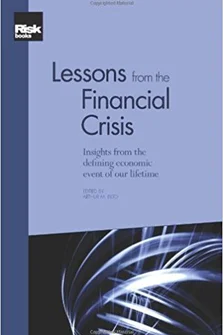The Credit Crunch of 2007: What Went Wrong? Why? What Lessons Can be Learned?
John C Hull
Introduction to 'Lessons from the Financial Crisis'
The Credit Crunch of 2007: What Went Wrong? Why? What Lessons Can be Learned?
Underwriting versus Economy: A New Approach to Decomposing Mortgage Losses
The Shadow Banking System and Hyman Minsky’s Economic Journey
The Collapse of the Icelandic Banking System
The Quant Crunch Experience and the Future of Quantitative Investing
No Margin for Error: The Impact of the Credit Crisis on Derivatives Markets
The Re-Emergence of Distressed Exchanges in Corporate Restructurings
Modelling Systemic and Sovereign Risks
Measuring and Managing Risk in Innovative Financial Instruments
Forecasting Extreme Risk of Equity Portfolios with Fundamental Factors
Limits of Implied Credit Correlation Metrics Before and During the Crisis
Another view on the pricing of MBSs, CMOs and CDOs of ABS
Pricing of Credit Derivatives with and without Counterparty and Collateral Adjustments
A Practical Guide to Monte Carlo CVA
The Endogenous Dynamics of Markets: Price Impact, Feedback Loops and Instabilities
Market Panics: Correlation Dynamics, Dispersion and Tails
Financial Complexity and Systemic Stability in Trading Markets
The Martingale Theory of Bubbles: Implications for the Valuation of Derivatives and Detecting Bubbles
Managing through a Crisis: Practical Insights and Lessons Learned for Quantitatively Managed Equity Portfolios
Active Risk Management: A Credit Investor’s Perspective
Investment Strategy Returns: Volatility, Asymmetry, Fat Tails and the Nature of Alpha
Starting in 2007, the US experienced the worst financial crisis since the 1930s. The crisis spread rapidly from the US to other countries and from financial markets to the real economy. Some financial institutions failed. Many more had to be bailed out by national governments. There can be no question that the first decade of the 21st Century has been a disastrous one for the world’s financial institutions and for the financial sector in general.
This chapter examines the origins of the crisis, what went wrong and why it went wrong. It also provides some observations on how similar crises can be avoided in the future.
The US housing market
Anatural starting point for any discussion of the credit crunch of 2007 is the US housing market. Figure 1.1 shows the S&P/Case–Shiller Composite-10 Index for house prices in the US between January 1987 and February 2009. Between 2000 and 2005, house prices rose much faster than they had in the previous decade. The very low level of interest rates between 2002 and 2005 was an important contributory factor but the increase was for the most part fuelled by mortgage lending practices.
The 2000–2006 period was characterised by a huge
Copyright Infopro Digital Limited. All rights reserved.
As outlined in our terms and conditions, https://www.infopro-digital.com/terms-and-conditions/subscriptions/ (point 2.4), printing is limited to a single copy.
If you would like to purchase additional rights please email info@risk.net
Copyright Infopro Digital Limited. All rights reserved.
You may share this content using our article tools. As outlined in our terms and conditions, https://www.infopro-digital.com/terms-and-conditions/subscriptions/ (clause 2.4), an Authorised User may only make one copy of the materials for their own personal use. You must also comply with the restrictions in clause 2.5.
If you would like to purchase additional rights please email info@risk.net











